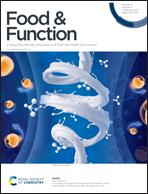Interfacial and emulsion-stabilizing properties of zein nanoparticles: differences among zein fractions (α-, β-, and γ-zein)†
Abstract
According to the solubility in the binary solvent of ethanol water, zein can be classified into α-, β-, γ-, and δ-zein, and the difference in amino acid compositions of these fractions is believed to affect their physicochemical properties and functionalities. This research comparatively analyzed main zein fractions, namely the α-zein fraction, β-zein fraction, and γ-zein fraction, on the formation, surface adsorption, and emulsifying properties of their anti-solvent-induced particles. Results showed that all zein fractions were able to form spherical particles through an anti-solvent procedure, and formed particles possessed different surface charge and surface hydrophobicity. γ-Zein fraction particles had the biggest size and lowest surface hydrophobicity, the highest interfacial adsorption speed, and formed the strongest viscoelastic interfacial film, as analyzed through the interfacial rheology results, while β-zein fraction particles exhibited the poorest interfacial activity. These physicochemical differences were reflected in their emulsifying properties, whereby the γ-zein fraction particle-stabilized emulsion had the maximum tolerance to salt (50, 100, and 200 mM NaCl) and pH (4.0, 7.0, and 9.0). The excellent interfacial properties of the γ-zein fraction presented in this research would afford a new strategy for the effective application of zein.



 Please wait while we load your content...
Please wait while we load your content...